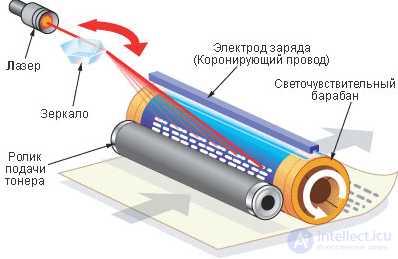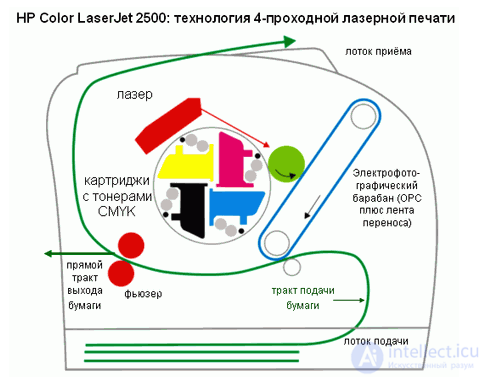Lecture
The mechanical components of laser printers become easier over time: the number of moving parts decreases, reliability increases and ease of maintenance increases.
The laser printing process is based on technology developed by Xerox. On a special photosensitive drum with a beam of light, areas charged with static electricity are created (a picture is drawn with a beam across the drum). The drum rotates in front of the cartridge, and the charged areas attract the toner, which consists of plastic-coated iron particles. Then the drum moves over a sheet of paper that is charged even more strongly than the drum. In this case, the toner particles are transferred from the drum to the paper and then sintered under heating, turning into a waterproof imprint.
The technological difference between the different models may lie in the way the "image" is created by the light beam on the drum. In real laser printers, a laser gun directed at a rotating mirror is used, the angle of its rotation determines the charged points of the drum, from which the image is formed.
Another way is to use a constant light source and a system of liquid crystal "windows" (diaphragms). As the drum rotates, they switch from a transparent state to an opaque state and vice versa, creating charged regions corresponding to the image. The further development of this technology was the use of a "strip" of LEDs (as in OKI printers).
The situation with photographic images containing shades of gray is somewhat more complicated. The area covered by several points is transformed (combined) into one large virtual point. It may look lighter or darker depending on the number of real points forming it. This creates the effect of gray gradations. Naturally, the higher the resolution of the printer, the more real points can be in one virtual, which means higher quality of the final image. An even more perfect way is to vary the size of each point.
In laser printers, in contrast to the matrix, can only be used sheet paper, but can not roll. The printing speed of laser printers varies considerably. It is for different models from 4 to 40 pages or more per minute.


The faster the printer prints, the more important the capacity of the paper feed tray.
Printers have different capacities of random access memory (RAM) used to store the fonts loaded into them (for example, Russian) and printed pages. A small capacity of RAM (512 KB) does not allow to print large (full page) images and at the same time store a sufficient number of fonts. If a printer is bought for making original layouts of books with a large number of drawings, then it is better to choose a printer with a large amount of RAM or additionally purchase several megabytes of memory.
Prices for personal and group laser printers have fallen, making them affordable for those people who would have previously chosen for themselves inkjet or matrix models.
The cost of a laser printer is influenced by two factors: resolution and speed. In the lower price range are devices capable of printing four pages per minute with a resolution of 600 dpi. More expensive models have a resolution of 1200 dpi or higher and print at eight or more pages per minute.
The most expensive consumable part of laser printers is toner. In some printers, the drum and toner are a single unit, and they have to be replaced at the same time, which incurs additional costs. An alternative are models with separate toner and drum. If you intend to print a lot, then this solution can save you money. However, the drum is also not forever: you have to replace it every 8,000–20,000 pages (depending on how much you usually print at a time). Costs of operation can be reduced by buying a printer with a cartridge that can be "recharged". Currently, there are many companies offering the exchange of empty cartridges to refilled for about half the cost of a new one. Although the powder in the cartridge is not poisonous, we do not recommend trying to recharge yourself: this is a very “dirty” procedure.
Another item of expenditure - additional features. For example, some models include the installation of additional trays for feeding paper, printer memory expansion modules, network tools, etc. One of the most “desirable” possibilities is the simultaneous printing on both sides of the paper. This feature is still a privilege of expensive models, however, if you plan to further upgrade your printer in this way, you need to make sure that it supports duplex printing before purchasing.
Color Laser Printers
Of course, it is unlikely that in the near future color laser printers will compare in popularity with color inkjet printers and will be used as desktop printing devices for personal use. However, the noticeable progress of technology in this area has recently made the price-quality ratio of print much more attractive.
According to various estimates, the market for color laser printers is still quite narrow - after all, their price, as they say, bites. Nevertheless, we must admit that the print quality of these devices is improving, and they themselves are becoming more and more attractive. If this goes on, then over time, color laser printing will compete with inkjet. For the time being, it is only “about” the implementation of numerous marketing forecasts, the authors of which predict a “simple” growth in the popularity of color laser printers, independent of the success of other types of printers.
Comments
To leave a comment
History of computer technology and IT technology
Terms: History of computer technology and IT technology